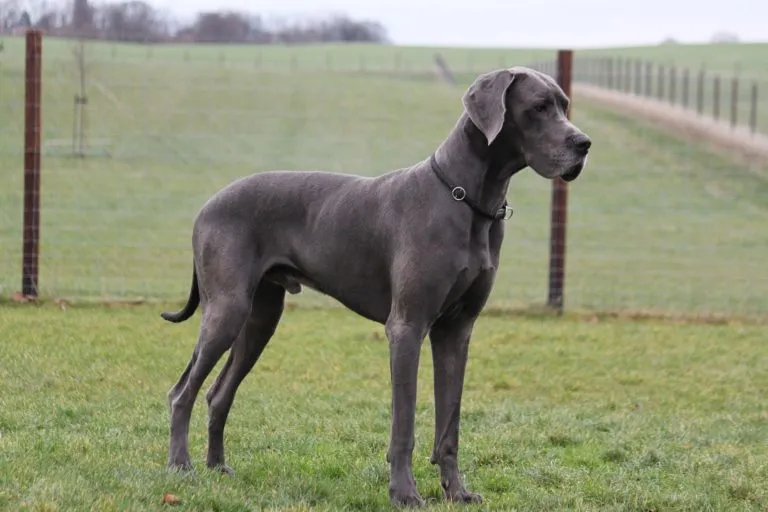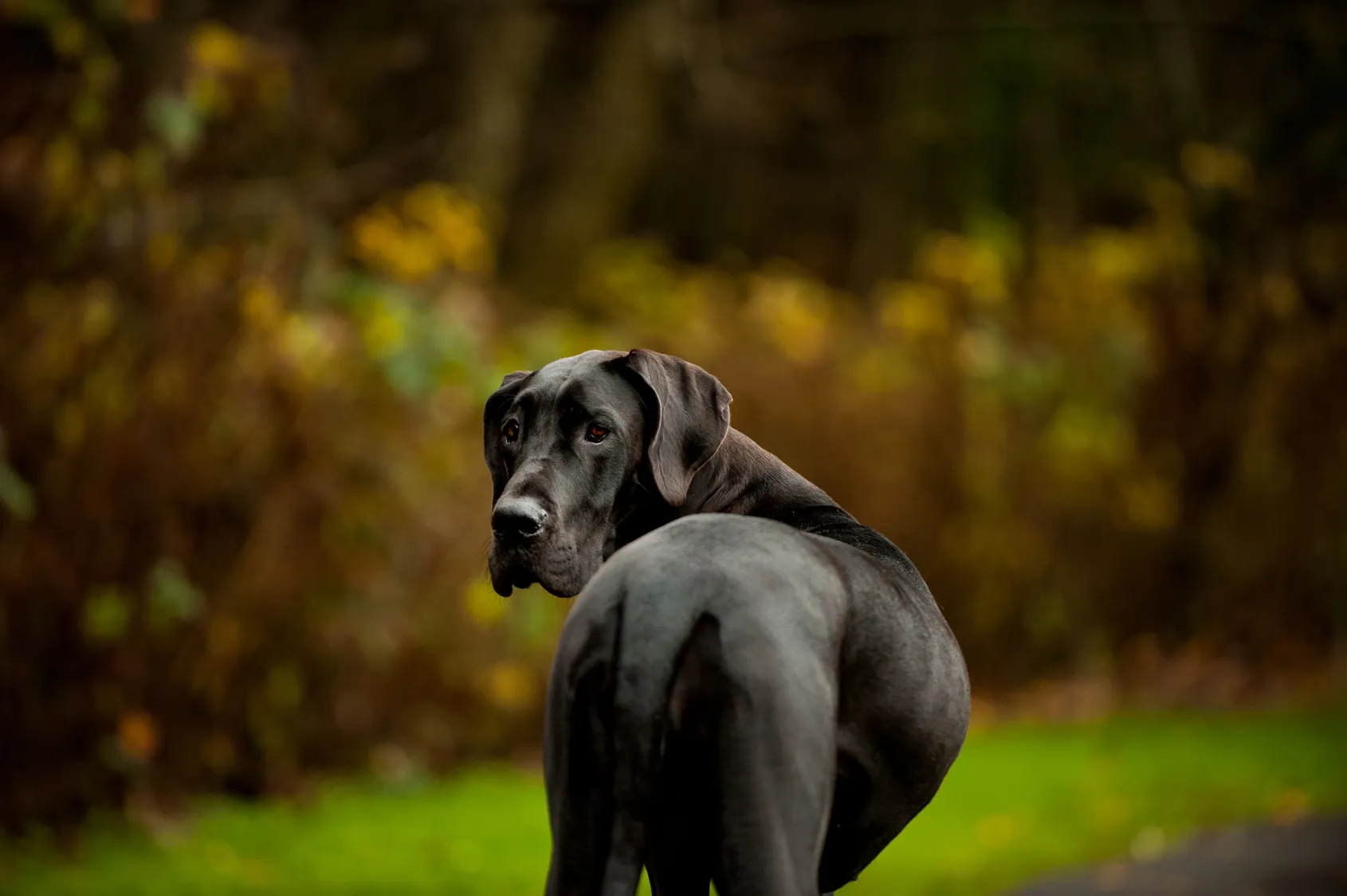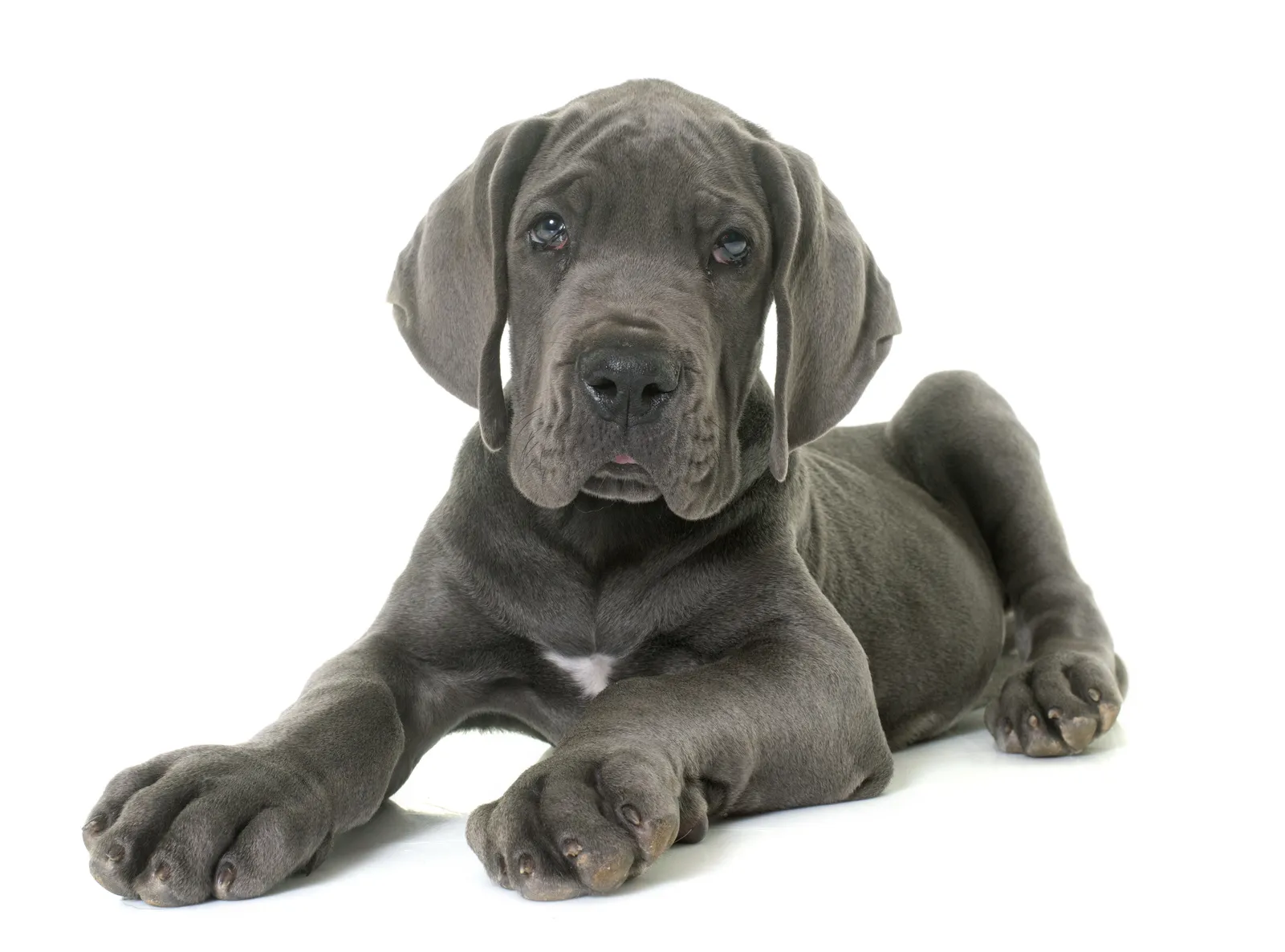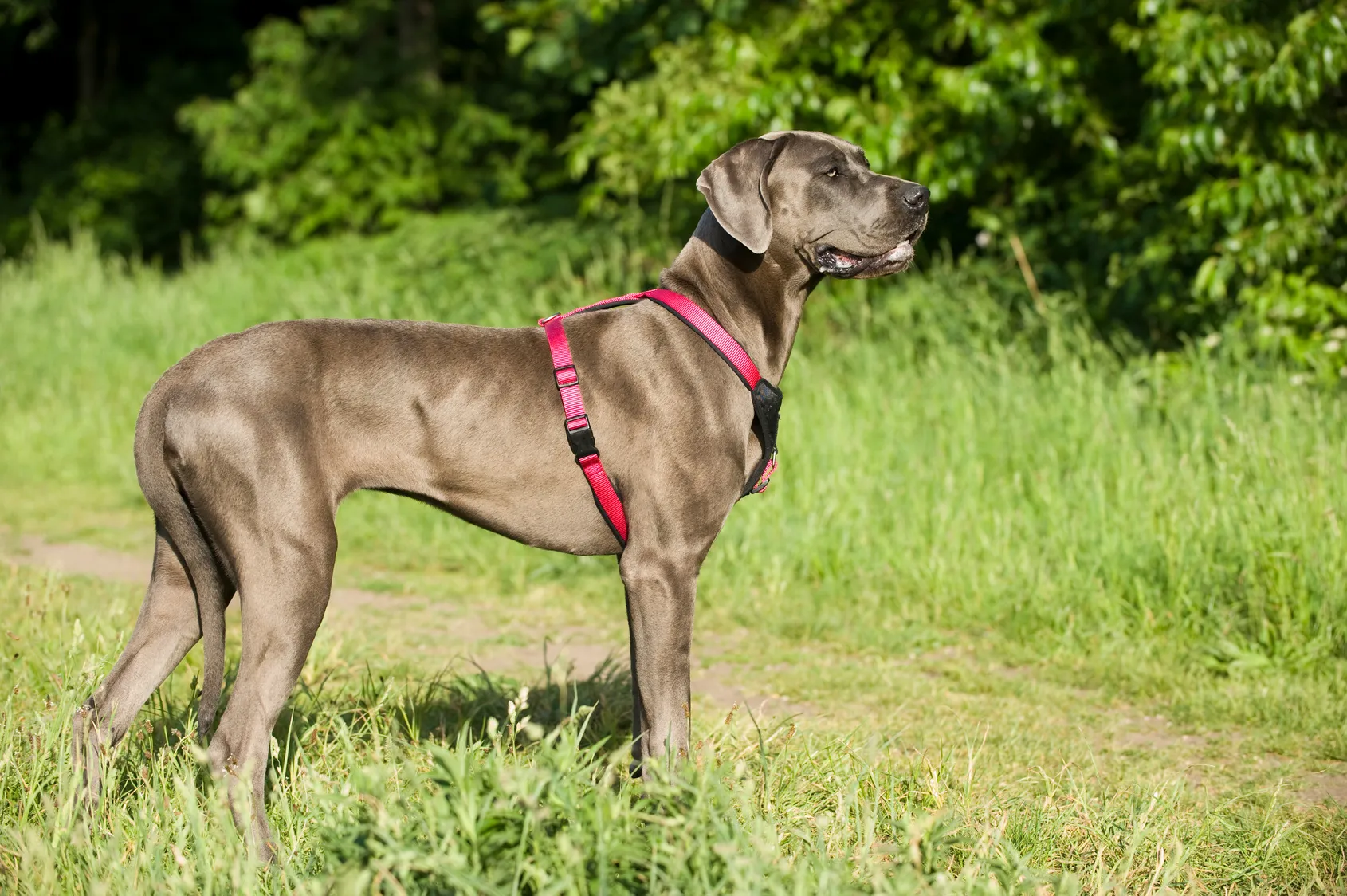Beagle
The Beagle's short legs can be deceiving – this medium-sized dog keeps you on your toes and is always full of surprises! This friendly breed is active, fearless and extremely clever.
The Great Dane is one of the largest dog breeds in the world. In spite of its imposing appearance and striking muzzle, this breed is in fact an extremely friendly, gentle and affectionate creature that loves to cuddle its owners, often forgetting its size and earning itself the nickname, “the world’s biggest lapdog”!

© Bianca / stock.adobe.com
The breed standard outlined by the World Canine Organisation describes the Great Dane as “loving and devoted to its owner”. These gentle giants hate to be left alone and are happiest when in the company of their owners. Their reserved and easy nature make them ideal companions for almost any living situation. Despite being people-loving dogs, they are not submissive creatures and their intelligence often surprises their owners, although not in an unpleasant way.
However, the Great Dane often faces fear and rejection in society, largely thanks to its enormous size. Great Dane owners often report hearing snippets of conversation when out and about with their dogs, including such ludicrous questions as, “Is that a dog or a pony?” People walking smaller dogs have even been regularly known to cross the road to avoid Great Danes, fearing that their little darlings will be in danger from these mammoth beings. If you ever find yourself in this situation, there is only one thing to do – stay calm! It is only natural that people will be intimidated by the sheer size of a Great Dane, but they can be quickly won over thanks to the friendly, docile and intelligent nature of this breed. And remember that for every negative reaction, you are bound to also receive positive, enthusiastic reactions to your four-legged friend!
Ultimately, the respect inspired by the Great Dane’s massive size can be a real asset in many situations. For example, they make very popular guard dogs. These attentive animals approach strangers initially with caution and scepticism, although they rarely bark or act in a threatening manner – not that they need to, as it’s safe to say that the majority of intruders would not voluntarily test their strength against a Great Dane! These dogs in fact have a very high tolerance threshold, rarely exhibiting angry or aggressive behaviour. When dealing with people or with other animals, they are generally considered to be extremely amicable. That is why Great Danes make such popular family pets, even fitting happily into families with young children. They love to play and cuddle with children, with only their immense size occasionally holding them back.
 © everydoghasastory / stock.adobe.com
© everydoghasastory / stock.adobe.com
An adult Great Dane can weigh around 90kg or more, which is unsurprising considering males are 80cm high at the withers and females around 72cm. However, despite its size, this breed is anything but slow or cumbersome. On the contrary, its proud overall appearance gives off an air of tremendous power and elegance. The breed standard describes it as an “Apollo amongst dog breeds”, thanks to its harmonious appearance, well-proportioned lines and expressive head. During the 16th and 17th Century, it was regarded as a precious treasure, and was often seen as a mark of nobility.
There are three main independent colourings for Great Danes, which standards dictate should not be mixed during breeding:
Fawn and brindle: fawn Great Danes are light to bright yellow. Brindle dogs have clear chevron markings running in the direction of the ribs. Both colours have a black mask around the eyes, eyebrows and sometimes ears, but white badges are to be avoided if possible.
Black and harlequin: the black Great Dane is a deep jet black, with white badges possible on the paws and chest. Special varieties of this colouring include “mantel” and “piebald”. Mantles have a solid black blanket over the body, with the muzzle, neck, chest, stomach, legs and tip of the tail appearing white. The piebald has large black patches around the base of the tail and the head, on an otherwise white body.
The harlequin Great Dane has a white base colour with uneven, torn black flecks spreading over the entire body. Such colouring is not pure and it is thus very difficult to specifically breed the correct markings. Only around 10% of puppies show the desired distribution of black spots.
Blue: blue Great Danes are a pure, steel blue colour. White badges are allowed, but only on the chest and paws.
In addition to these main colourings, there are also other colourings such as merle or grey merle, which may appear frequently but are undesired by the breeding standard. Grey merles have a grey base colour with black flecks. Although many other breeds such as hunting dogs see grey as a desirable colour, grey merle Great Danes never obtain the highest marks at dog shows. The breeding of white Great Danes (white merles) is forbidden in Germany, as breeding spotted/non-spotted pairs can result in great suffering for the animals. Spotted Great Danes can be carriers of the so-called “Merle Factor” – if both parents in a spotted pair pass this gene on to their offspring, it can result in puppies affected by blindness or partial deafness.
 © cynoclub / stock.adobe.com
© cynoclub / stock.adobe.com
In the late 19th century, experts in dog breeds believed they had found the ancient ancestors of the Great Dane. Over 4000 years ago, the Assyrians had large, blunt-nosed, shorthaired fighting dogs, whose appearance was remarkably similar to that of the modern Great Dane. In Denmark, too, skeletons of large hounds resembling Great Danes were found, dating back to around 5000 BC to 1000 AD. However, a clear relationship between Great Danes and these ancient ancestors is very controversial and widely disputed. Supposed links to the Tibetan Mastiff or Do Khyi, one of the oldest Eastern dog breeds, have already been conclusively disproved with DNA testing.
Definitive records to the Great Dane’s origins can only be traced back as far as the 16th Century onwards. Traditions passed down through the years show that particularly large, elegant dogs coming from crosses between Mastiffs and Irish Wolfhounds were introduced to Germany from England and Ireland. Although they still differed greatly in precise appearance, the extraordinarily large size was a common factor. From the 17th Century onwards, the targeted breeding of so-called “Englische Docke”, simply “English Dogs” began in Germany. These large, proud dogs were used to hunt bears, wild boar and other animals, and were soon regarded as impressive companion dogs for farms. This led to the division of the breed into chamber dogs, hounds and “English Dogs”.
The chamber dogs were the strongest, most beautiful examples of the breed and were honoured with gilded collars and comfortable bearskin beds, charged with protecting their owners as they slept. Both chamber dogs and hounds were supposed to protect the household from intruders, but the hounds were considered less beautiful and were thus only given silver collars. As these dogs were designed to live within the family households of the nobility, breeding focussed on character traits such as obedience and leadership. Those used for hunting were spared these high breeding standards.
However, even the English mastiffs were so valuable that they were rarely used for hunting, despite not being considered as important as the chamber dogs or hounds and being kept outside in the stables. Boarhounds were instead sent out on the bear hunts, in order to rile up the prey and drive it out of the forest. Once the wild boar or bears were spotted, the hounds would be released, with the aim of achieving a strong bite to hold the animal in place until a hunter could stab it. In order to protect the valuable dogs from injury during these activities, they wore thickly lined fabric coats as a kind of armour.
Over the years, hunting dogs became more and more superfluous, due to the increased use of firearms as hunting weapons. Many breeds, therefore, disappeared from the scene, with Great Danes becoming status symbols and luxury objects, particularly in areas such as Württemberg, Germany. By the middle of the 19th Century, the modern-day Great Dane had become a well-loved breed of increasing popularity. Otto von Bismarck himself is thought to be one of the most famous owners of a Great Dane. The First Chancellor of the German Reich kept these dogs for more than 60 years, earning the breed the nickname, “Dog of the Empire”.
As Great Danes were kept primarily in private households, particular attention was paid to breeding good character, balanced temperament and obedience. Different types of Great Dane appeared throughout the country, differing slightly in colour or size and becoming known by a range of different names, with Ulmer Dane, Danish Dane and Tiger Dane being just a few.
When, in 1876, all of these varying breeds were displayed at a dog show, the judges proposed to breeders that a uniform description for the “Great Dane” be decided upon. The name itself was not considered controversial, as many different countries simply claimed the origins of the Dane for themselves. That is why the breed is known to this day as the “Great Dane”, although the first official breed association in Germany, founded in 1888, was named the “Deutschen Doggen Club”, literally meaning “German Mastiff Club”.
 © DoraZett / stock.adobe.com
© DoraZett / stock.adobe.com
The Great Dane Club (1888) has its headquarters in Berlin and remains to this day the standard-setter for the breed, under the umbrella of the World Canine Organisation. Nowadays, breeding is focused on a calm temperament and friendliness. This gentle, loving nature is due largely to the fact that this breed is a beloved, popular family dog in spite of its size. There are also, of course, those who own Great Danes purely for the prestige brought by their impressive size.
Popular and well loved, this breed still struggles with a range of breed-specific diseases. Their size also means that Great Danes are highly susceptible to hip joint dysplasia (HD), twisted stomach, bone cancer and myocardial disorders. A staggering 28% of Great Danes will die before their fifth birthday, with hardly any reaching the age of ten. If bred incorrectly, the susceptibility to disease could be increased still further. For example, breeding with the aim of forming strong lips leads to a raised risk of conjunctivitis.
With the help of prudent breeding that focuses more on the health and longevity of the dogs rather than merely on their size, the risk of disease can be significantly reduced. However, as with most dogs, exercise and nutrition also play a key role. In order to keep your Great Dane fit and healthy for as long as possible, the tendons and muscles should be well trained and exercised. A long walk every day involving sections where the dog can “let off steam” off the lead is a must for this breed. Stairs should be avoided if possible, and young puppies should refrain from long walks, boisterous games and climbing stairs. Therefore, this dog is more suited to spacious houses on ground level and with a large amount of garden.
Questions about diet and nutrition are best answered by your puppy’s breeder or veterinarian. Naturally, such a large dog will require “more” of everything – more space, more exercise and more food!
Great Danes are generally very uncomplicated, simple animals that work well as family and companion dogs, thanks to their easy nature and strong sense of loyalty. These big-hearted animals can also be ideal as therapy dogs. As with all dogs, the Great Dane requires loving but consistent training, in order to ensure that its positive nature can fully develop. Not least because of the potential consequences of their size, these dogs need people by their side that set out clear borders for them and whose power they can trust. The key to keeping a Great Dane happy is close contact with humans. Such a loving, devoted dog with such a tendency to drool may mean that pristine jeans have to take a backseat during life with a Great Dane!
The Beagle's short legs can be deceiving – this medium-sized dog keeps you on your toes and is always full of surprises! This friendly breed is active, fearless and extremely clever.
The Golden Retriever is still one of the most popular dog breeds, especially with families. It is defined not just by its docility, but shows numerous other qualities too. Read in the following article everything you need to know about the Golden Retriever.
The German Shepherd is one of the most popular utility dog breeds in the world, though the willing-to-learn and people-focused nature of these versatile dogs also makes them suitable for family life.